Second Entry in Jordan
We had two big field trips over the last two long weekends. On the first weekend, we went and toured the "Desert Castles" in the north of Jordan. They weren't really castles, most were forts, but they are definitely in the desert. On the second weekend, we went to the ancient site of Petra, rode camels, spent the night sleeping in the desert, and visited the Dead Sea on the way back. Definitely a busy weekend!
Umm Al-Jimal
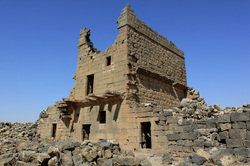
This is part of the ruins of the town of Umm Al-Jimal (which either means 'mother of beauty' or 'mother of camels,' depending on how you pronounce it). It was occupied way back when the Romans and then Byzantine empires controlled all over the Mediterranean area - including Jordan! The area that is now Jordan has been attacked and controlled by many different groups over time. It became its own country in the 1940s, after it gained independence from the British.
Neighboring Countries
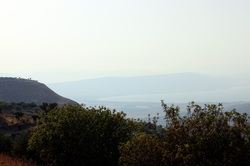
This is a hazy photograph of the Sea of Galilee (or the Sea of Tiberius), which is actually in Israel! We were in the northeastern corner of Jordan, and just downhill from the big bluff we were on is the country of Israel. The Sea of Galilee is famous, because it is mentioned a lot in the New Testament of the Bible. If you turned clockwise about 90 degrees from here (to the north), you could also see into the country of Syria, which is the northern border of Jordan. Jordan also shares a border with Iraq to the east and Saudi Arabia to the south. It is incredible to be able to stand in one spot and see two more countries!
Petra!
Petra is one of the most famous ancient sites in Jordan. It is a huge city that once contained more than 30,000 people! The Nabotean people who lived in Petra carved amazing tombs and buildings into the side of the cliffs. We were all very excited to spend a full afternoon hiking and site-seeing in Petra.
First, let me tell you, it was HOT. Hot as in over 100 degrees Fahrenheit hot. Hot as in you had to constantly drink water every three steps so you wouldn't dehydrate hot. Plus, being adventurous, I decided to join the group doing the "intense" tour. After a mile long hike down toward the Treasury (see below), we immediately headed up about 300-400 steps to the top of the cliffs to see the "High Point of Sacrifice." Yikes! Thankfully, we stopped half way up to visit with Jay's friend Hanan (see below). Pfew!
First, let me tell you, it was HOT. Hot as in over 100 degrees Fahrenheit hot. Hot as in you had to constantly drink water every three steps so you wouldn't dehydrate hot. Plus, being adventurous, I decided to join the group doing the "intense" tour. After a mile long hike down toward the Treasury (see below), we immediately headed up about 300-400 steps to the top of the cliffs to see the "High Point of Sacrifice." Yikes! Thankfully, we stopped half way up to visit with Jay's friend Hanan (see below). Pfew!
Bedouin
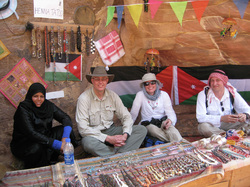
The Bedouin people are the original inhabitants of Jordan, and many choose to live in traditional ways. Many Bedouin people live in the area around Petra, and some make their living selling items to tourists. Here we are with Hanan, a Bedouin friend of Jay (on her left) who was leading our group. I am wearing a hat over my headscarf to keep the sun off my face and neck - it was roasting! Hanan served us Bedouin tea (it was delicious!), and I bought my rock necklace here as a souvenir.
The Treasury
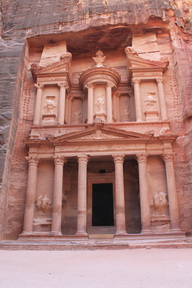
This is the most famous view in Petra. (It was even featured in the movie "Indiana Jones and the Last Crusade.") It is pretty amazing that the Nabotean people carved this whole building right out of the cliff itself. If you look very closely on the sides, you can see two little rows of holes that the carvers used to climb up and down! Whoa. They must have been incredibly brave (as well as talented)! The doorway is WAY bigger than a regular doorway, so the building looks even bigger in person.
Into the Desert: the Wadi Rum
Much of Amman is a desert. In fact, only 5% of the land in Jordan is good for farming. Most of the farming is along the banks of the Jordan River, which forms the border between Jordan and Israel/Palestine. Vegetables grow really well here, and the most common are tomatoes, cucumbers, and watermelons. Grapes and olives also grow well on the plateau area. As for animals, there are about 24 million chickens, 1.5 million sheep, and about 600,000 goats! We saw many herds of sheep and goats along the road, and sometimes we even had to stop our bus to wait for them to cross the street!
But now, we were headed to the Wadi Rum, the most photographed desert in Jordan. It has beautiful dunes of deep red sand and lovely cliffs that kind of look like they are melting and having many many layers. Gorgeous. It was so incredible to spent a night in the desert and to watch how all the colors of the rocks and sand changed in the day, sunset, nighttime, and early morning. But first, I had to learn to ride a camel!
But now, we were headed to the Wadi Rum, the most photographed desert in Jordan. It has beautiful dunes of deep red sand and lovely cliffs that kind of look like they are melting and having many many layers. Gorgeous. It was so incredible to spent a night in the desert and to watch how all the colors of the rocks and sand changed in the day, sunset, nighttime, and early morning. But first, I had to learn to ride a camel!
Riding a Camel
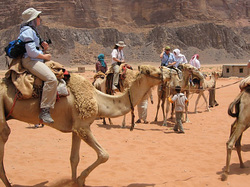
Here I am on my camel! The camels were sitting down when we walked up, and then stood up after we got on. THAT was a scary experience - I thought I might fall off! But once we were up, it was much smoother (you can see I am even using one hand to hold my camera). You can also see one of the Bedouin boys who was helping to lead our camel caravan. Can you see how red the sand was? I took a bunch of pictures from the camel, but this is one a friend took of me.
A Traditional Bedouin Tent
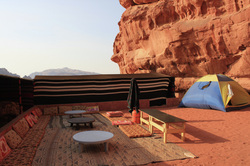
This is the camp where we spent the night. There were two tents and the central courtyard where we had dinner. We all sat on the mats (and later slept on similar ones too). Although many Bedouin have modern cement or wooden houses, some still also live in traditional tents, like their ancestors did. It was amazing how just that little bit of shade could make you feel so much nicer and cooler. We actually decided to sleep out under the stars for the night, so we dragged our cushions out of the tent and laid them on the sand.
